|
|
|
| The
wrasses are a particularly diverse and
abundant family of reef fishes, with
numerous species that occupy essentially
all reef, rock, and grassbed habitats
in the Caribbean. The bluehead wrasse,
Thalassoma
bifasciatum, is the single regional
representative of a prominent labrid
genus and is ubiquitous on Western Atlantic
coral reefs. Another large genus of
wrasses, Halichoeres,
has more than 80 species throughout
the tropics with many regional representatives,
not all of which are closely related.
There are three local razorfishes in
Xyrichtys
(note that Xyrichtys is frequently
misspelled as Xyrichthys) and
two hogfishes in Bodianus.
The remaining labrid genera in the region
are mostly monotypic: Doratonotus
megalepis, Lachnolaimus
maximus, Clepticus
parrae, and the deep-water wrasse
Decodon
puellaris (the latter two species
have a sibling species in the eastern
Atlantic and in the eastern Pacific,
respectively). |
|
|
|
Labrid larvae can be recognized by the
absence of head spines, long and continuous
dorsal and anal fins with slender spines,
a relatively wide caudal peduncle, stub-like
pelvic fins, a pointed snout with a small
terminal mouth and typically light markings
(none or melanophores mostly on the fin-ray
membranes). Notably, there is no row of
melanophores along the anal-fin base, which
separates labrid larvae from many similar-appearing
groups, such as larval scarids,
labrisomids,
chaenopsids,
dactyloscopids,
and gobies.
While most tropical labrid larvae fit this
general pattern of small and mostly unpigmented
larvae, two genera are exceptions: larval
Lachnolaimus
maximus are fully-pigmented and
Decodon
melasma have an unusual and large
late larval stage with a pattern of bars
on the body.
|
| |
|
| Pre-transitional
labrid larvae can have unusual eye morphology:
many larval Halichoeres
and Thalassoma
have eyes that are narrowed vertical ovals,
usually tilted backwards, but sometimes forwards.
Larval Xyrichtys
have markedly-narrowed vertically
oval eyes. Other larval labrids, such as Doratonotus
megalepis, have round eyes throughout
development. These eye shapes likely reflect
differing life styles of these early life
history stages in the pelagic environment. |
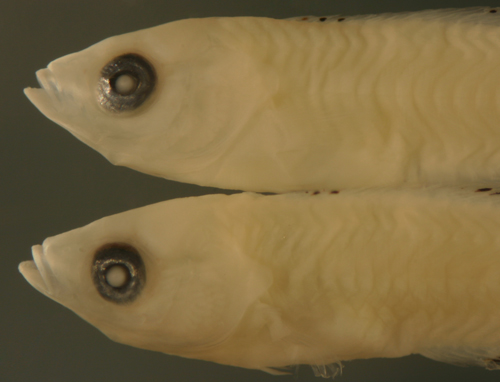 |
|
| While
genera are relatively easily distinguished,
congeneric labrid larvae can appear similar,
if not identical. Several species of Halichoeres
share melanophore patterns and only
become recognizable to species during transition.
Larval razorfishes, Xyrichtys,
have no melanophores and do not diverge in
appearance until juvenile markings develop
(however their evanescent chromatophore patterns
may be species-specific). Some Caribbean labrid
larvae require DNA sequencing for identification
to species. |
|
| The
labrids below are presented in order of increasing
numbers of dorsal-fin spines: from 8 to 14
in the regional labrids. Fin-ray counts generally
separate Caribbean genera well. |
|
|
|
|
| |
|
|
|
|
| This
large genus of labrids has only two representatives
in the western Atlantic: the widespread Bluehead
Wrasse Thalassoma
bifasciatum and its Brazilian relative
T. noronhanum. Several more species
are found in the eastern Pacific and many
others are native to the Indo-Pacific. The
larvae of Pacific species are almost identical
to the larval T.
bifasciatum described below, but are
missing the patch of melanophores at the front
of the dorsal fin. Although usually described
as having no melanophores, many larval Thalassoma
I have collected in the Pacific Ocean have
the same small melanophores along the edge
of the membranes of the dorsal and anal fins
and upper and lower membranes of the caudal
fin as are found on larval T.
bifasciatum. Note however, that only
larvae in particularly good condition will
have intact edges of the membranes. |
|
| Edge
melanophores on a T. grammaticum larva,
13.0 mm SL, Clipperton Island. |
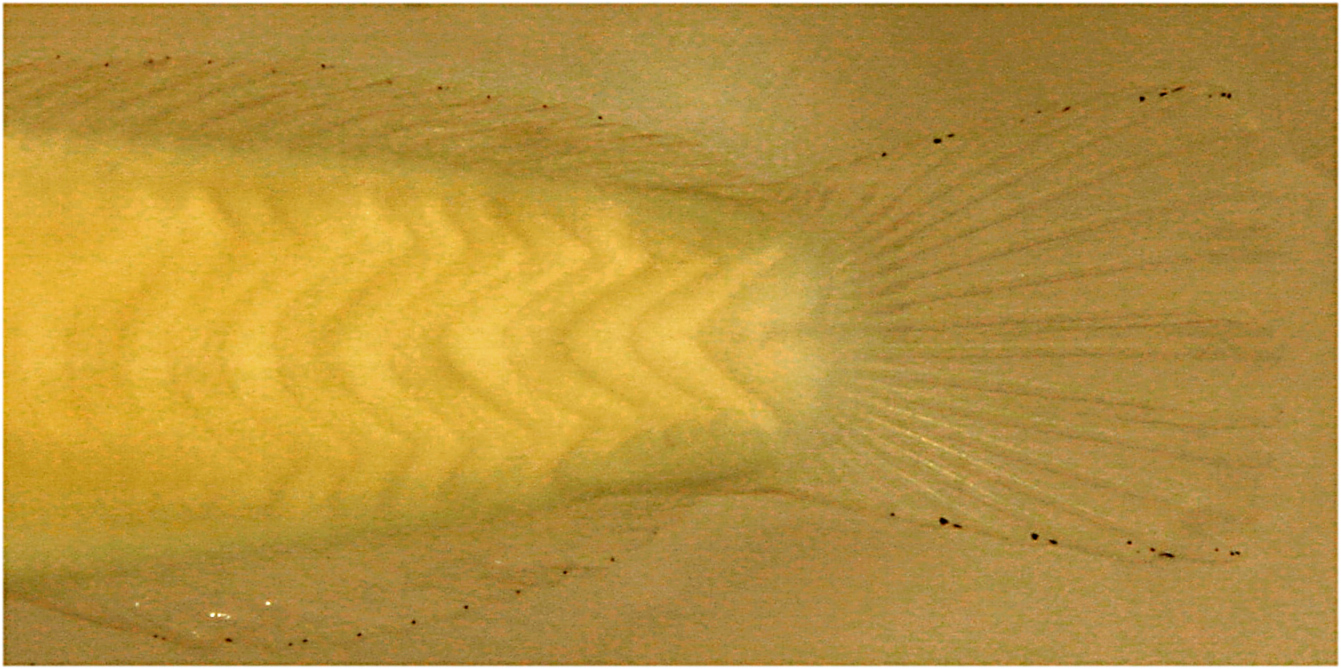 |
|
|
| |
|
|
|
| Diagnosis:
The fin-ray count of D-VIII,13 A-III,11
indicates Thalassoma
bifasciatum. |
|
|
|
Analogues: Larval
Thalassoma have distinctive edge melanophores
along the median fins, although these melanophores
may be absent in earlier stages and where
the fins are not fully intact. Halichoeres
larvae have additional patches of melanophores
along the mid and rear dorsal and anal-fin
membranes vs. the solitary anterior patch
on the dorsal-fin spines of Thalassoma
bifasciatum.
Larval Bodianus
rufus can appear somewhat similar
but have a wider body, a larger round eye,
and the dorsal-fin origin is distinctly farther
back on the body. |
|
|
Description:
Body relatively thin, narrow, and long
with a large eye and a terminal, small mouth.
Pectoral fins medium, reach to vent. Pelvic
fins very short. Dorsal and anal-fin bases
long, caudal peduncle short and relatively
wide. Melanophores limited to the fin-ray
membranes, in a group along the first two
or three dorsal-fin spines and then on the
membrane fringes along the dorsal, anal, and
caudal fins. Series of larvae show development
of the eye from vertically oval to round (round
in many larvae captured over the reef).
Transitional recruits develop a prominent
black spot on the front of the dorsal fin,
a wide black stripe along the side from nose
to tail and a dorsal stripe from the top of
the head along the base of the dorsal fin.
Transitional recruits on the reef commonly
show remnants of the melanophores on the fin-membrane
edges characteristic of the larvae. |
|
|
|
| Thalassoma
bifasciatum larva |
| 11.3 mm SL |
| San Blas, Panama,
SB81-051 |
|
 |
| |
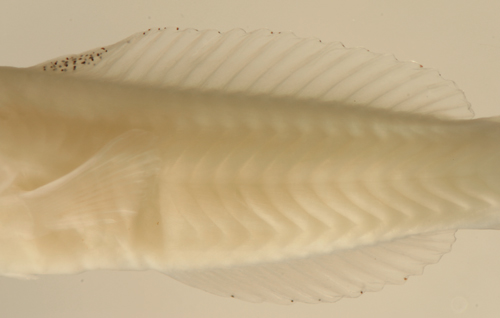 |
| |
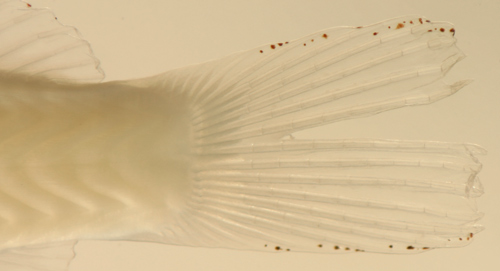 |
| Thalassoma
bifasciatum new recruit |
| 11.4 mm SL |
| San Blas, Panama,
SB81-001 |
|
 |
|
|
|
|
|
|
|
|
| This
large genus includes eleven regional species,
two of which have only recently been discovered
(H. socialis
from mangrove habitats in Belize (Randall
and Lobel 2003) and H.
burekae from deep reefs in the Gulf
of Mexico (Weaver and Rocha 2007)). In addition,
the northern (coastal USA) population of H.
bivittatus is genetically divergent
and represents a cryptic species. The phylogeny
of the genus is presently in flux and it is
likely that it will be split into three, or
perhaps many more, genera (there are numerous
unrelated lineages in the Indo-Pacific). Most
Caribbean species share a basic fin-ray count
of D-IX,11 A-III,12 and Pect-13 (H.
maculipinna and H.
cyanocephalus have slightly differing
fin-ray counts). |
|
| My
DNA-sequence analysis reveals that there is
a large clade of Atlantic Halichoeres
made up of H.
bivittatus, H.
garnoti, H.
poeyi, H.
radiatus, and H. cyanocephalus
(and its Brazilian sibling H. dimidiatus).
There is a smaller related clade made up of
H.
pictus and H.
socialis (along with the eastern Pacific
H. dispilus and H. insularis).
My results confirm that H.
maculipinna falls out well away from
the other Halichoeres
and nearer to Thalassoma (Barber
and Bellwood 2005). |
|
| The
larvae of a number of Halichoeres
overlap in appearance and DNA sequencing is
necessary to confirm the species for those
larvae. The species do become distinct as
they develop juvenile markings. The size at
settlement for this genus is quite consistent,
around 10-12 mm (interestingly, one eastern
Pacific sibling, H. insularis, settles
much larger, up to 22 mm SL). An unusual aspect
of the early life history of these labrids
is that larvae undergoing transition are not
captured in pelagic sampling, but are found
buried in sand and rubble on reefs. This attribute
is shared with Thalassoma
bifasciatum, but not with Doratonotus
megalepis or the related parrotfishes,
both of which begin transition while still
pelagic and transitional larvae are commonly
caught in nearshore collections. Interestingly,
I did collect one transitional larva of H.
poeyi at a nightlight in Panama and it
was the single largest Halichoeres
larvae out of many hundreds collected,
i.e. 13.8 mm SL. |
|
|
|
|
|
|
|
|
|
| Diagnosis:
The fin-ray count of D-IX,11 A-III,12
and Pect-13 indicates Halichoeres
and is shared by most of the Caribbean
species. Larval
H. bivittatus are identical to most
other larval Halichoeres with five
patches of median-fin melanophores and can
only be identified by DNA sequencing. |
|
| Analogues:
|
|
Description:
Body relatively thin, narrow and long
with a large eye and a terminal, small mouth.
Pectoral fins medium, reach to vent. Pelvic
fins very short. Dorsal and anal-fin bases
long, caudal peduncle short and relatively
wide. Melanophores limited to the fin-ray
membranes, typically occurring in five groups:
at the front, mid, and rear dorsal fin and
the front and rear anal fin. Each melanophore
group covers from one to five fin spines or
rays. Series of transitional larvae show development
of the eye from vertically oval (and tilted
backward) to round (round in many larvae captured
over the reef).
Transitional recruits of H.
bivittatus have a mid-dorsal fin ocellus
and a mid-lateral body stripe extending directly
rearward from the eye, present even in the
earliest transitional stages. Transitional
recruits on the reef commonly show remnants
of the larval melanophores on the fin membranes. |
|
|
|
| Halichoeres
bivittatus larva |
| 10.8 mm SL |
| few melanophores |
| San Blas, Panama,
SB81-118 |
|
 |
| Halichoeres
bivittatus larva |
| 11.9 mm SL |
| many melanophores
|
| San Blas, Panama,
SB81-023 |
|
 |
| Halichoeres
bivittatus larva |
| 10.3 mm SL |
| oval eye |
| San Blas, Panama,
SB81-125 |
|
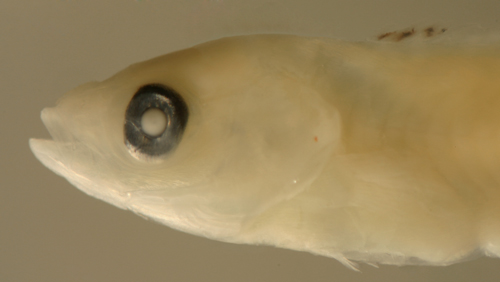 |
|
|
|
|
|
|
|
|
| Diagnosis:
The fin-ray count of D-IX,11 A-III,12
and Pect-13 indicates Halichoeres
and is shared by most of the Caribbean
species. Larval
H. radiatus are identical to most other
larval Halichoeres with five patches
of median-fin melanophores and can only be
identified by DNA sequencing. |
|
| Analogues:
|
|
Description:
Body relatively thin, narrow and long
with a large eye and a terminal, small mouth.
Pectoral fins medium, reach to vent. Pelvic
fins very short. Dorsal and anal-fin bases
long, caudal peduncle short and relatively
wide. Melanophores limited to the fin-ray
membranes, typically occurring in five groups:
at the front, mid, and rear dorsal fin and
the front and rear anal fin. Each melanophore
group covers from one to five fin spines or
rays.
Transitional recruits have a mid-dorsal fin
ocellus, a white-edged black spot on the upper
base of the central caudal-fin rays and a
patchy pattern of melanophores along the body
with a mid-body bar extending from the dorsal
ocellus down onto the anterior anal-fin rays. |
|
|
|
| Halichoeres
radiatus transitional recruit |
| 11.9 mm SL |
| San Blas, Panama,
SB82-018 |
|
 |
|
|
| |
| |
|
|
|
|
| Diagnosis:
The fin-ray count of D-IX,11 A-III,12 and
Pect-13 indicates Halichoeres
and is shared by most of the Caribbean
species. Larval
H. garnoti
are identical to most other larval Halichoeres
with five patches of median-fin melanophores
and can only be identified by DNA sequencing. |
|
| Analogues:
|
|
Description:
Body relatively thin, narrow and long
with a large eye and a terminal, small mouth.
Pectoral fins medium, reach to vent. Pelvic
fins very short. Dorsal and anal-fin bases
long, caudal peduncle short and relatively
wide. Melanophores limited to the fin-ray
membranes, typically occurring in five groups:
at the front, mid, and rear dorsal fin and
the front and rear anal fin. Each melanophore
group covers from one to five fin spines or
rays.
Transitional recruits of H.
garnoti develop a mid-lateral body
stripe from the lower half of the eye to the
tail, extending onto the base of the caudal-fin
rays. There is no dorsal fin ocellus. The
stripe is iridescent blue against a bright
yellow body in life; in preserved specimens
the stripe is underlain with fine melanophores. |
|
|
|
| Halichoeres
garnoti transitional recruit |
| 12.7 mm SL |
| larval melanophore
remnants |
| San Blas, Panama,
SB80-105 |
|
 |
| |
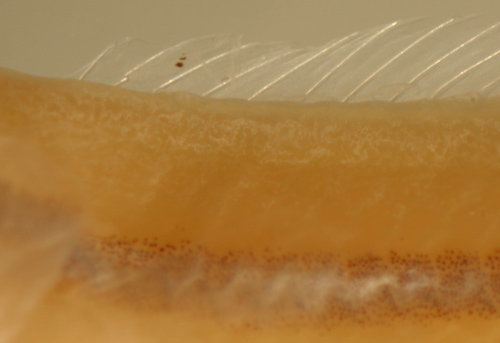 |
|
|
| |
| |
| |
|
|
|
| Diagnosis:
The fin-ray count of D-IX,11 A-III,12
and Pect-13 indicates Halichoeres
and is shared by most of the Caribbean
species. Larvae with a total of four patches
of melanophores on the dorsal and anal fins
(missing the anterior patch of dorsal fin
melanophores) represent H.
poeyi (confirmed by DNA sequencing).
|
|
| Analogues:
|
|
Description:
Body relatively thin, narrow, and long
with a large eye and a terminal, small mouth.
Pectoral fins medium, reach to vent. Pelvic
fins very short. Dorsal and anal-fin bases
long, caudal peduncle short and relatively
wide. Melanophores on the fin-ray membranes
typically occurring in in four groups: at
the mid and rear dorsal fin and the forward
and rear anal fin. Each melanophore group
covers from one to five fin spines or rays.
Most, but not all, larvae have a sub-surface
melanophore at the top of the head behind
the skull, sometimes two or three. Many of
the larvae also have a small melanophore on
the body at the ventral midline just after
the last anal ray (often unnoticed adjacent
to the large anal-fin membrane melanophores).
Unlike other larval Halichoeres,
this species has internal melanophores along
the dorsal peritoneal cavity. The one transitional
larva captured had begun to develop surface
melanophores on the head.
Transitional recruits of H.
poeyi have a mid-dorsal fin ocellus,
a spot on the caudal peduncle just behind
the base of the last dorsal ray, a white-edged
black spot on the upper base of the central
caudal-fin rays, a chain-link patch pattern
along the lateral midline, and colored striping
on the top of the head. Some variants lack
the chain-link pattern and have melanophores
uniformly covering the upper and lower sides
of the body with a mid-lateral band with no
melanophores. Transitional recruits on the
reef commonly retain the larval melanophores
behind the skull and remnants of the larval
melanophores on the fin membranes. |
|
|
|
| Halichoeres
poeyi larva |
| 12.6 mm SL |
| San Blas, Panama,
SB86-331 |
|
 |
| Halichoeres
poeyi larva |
| 12.5 mm SL |
| dorsal peritoneal
melanophores |
| San Blas, Panama,
SB80-102 |
|
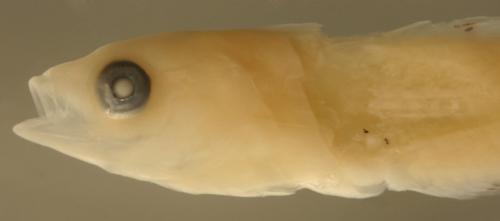 |
| Halichoeres
poeyi transitional larva |
| 13.8 mm SL |
| head melanophores |
| San Blas, Panama,
SB80-102 |
|
 |
| |
 |
| Halichoeres
poeyi early transitional recruit |
| 11.1 mm SL |
| San Blas, Panama,
SB83-137 |
|
 |
| Halichoeres
poeyi early transitional recruit |
| 11.6 mm SL |
| San Blas, Panama,
SB83-148 |
|
 |
|
|
|
|
|
|
|
|
| Diagnosis:
The fin-ray count of D-IX,11 A-III,12
and Pect-13 indicates Halichoeres
and is shared by most of the Caribbean
species. |
|
| Analogues:
|
|
Description:
Body relatively thin, narrow and long
with a large eye and a terminal, small mouth.
Pectoral fins medium, reach to vent. Pelvic
fins very short. Dorsal and anal-fin bases
long, caudal peduncle short and relatively
wide.
|
|
|
|
| Halichoeres
radiatus transitional recruit |
| 11.9 mm SL |
| San Blas, Panama,
SB82-018 |
|
|
|
|
| |
| |
|
|
|
|
| Diagnosis:
The fin-ray count of D-IX,11 A-III,11
and Pect-14 indicates Halichoeres
maculipinna. This species has one fewer
anal-fin ray than the other Halichoeres
in the region and both larvae and
recruits have a different morphology, appearing
wider and thicker-bodied. |
|
| Analogues:
|
|
Description:
Body relatively thin, wide and long
with a medium eye and a terminal, small mouth.
Pectoral fins medium, reach to vent. Pelvic
fins very short. Dorsal and anal-fin bases
long, caudal peduncle short and wide. Melanophores
limited to the fin-ray membranes, typically
on the last few dorsal-fin rays and a matching
group on the last anal-fin rays. Each melanophore
group covers from three to five fin rays.
Transitional recruits of H.
maculipinna show more variable markings
than other labrids. Those individuals in grassbeds
are uniformly green, while those on reefs
have a distinct black stripe along the side
of the body. |
|
|
|
| Halichoeres
maculipinna larva |
| 12.7 mm SL |
| Barbados, coll.
by Henri Valles |
|
 |
|
|
|
|
|
|
|
|
| Diagnosis:
The fin-ray count of D-IX,12 A-III,12
and Pect-12 indicates the razorfish genus
Xyrichtys.
One other regional labrid, Halichoeres
cyanocephalus, shares the median-fin
ray count, but has 13 pectoral-fin rays and
a clearly different body shape. The three
Caribbean razorfishes, X. martinicensis,
X.
novacula, and X.
splendens, share fin-ray counts and
the larvae can overlap in appearance. The
species become distinct as they develop juvenile
markings: X. martinicensis recruits
are recognized by a simple lateral stripe
from the eye to the tail that is not broken
up into patches or spots. |
|
| Analogues:
Larval Xyrichtys
have no melanophores and often markedly-narrowed
eyes. The absence of external melanophores
is shared with larval Doratonotus
megalepis, which are distinctly wider-bodied
and have large round eyes. All other regional
labrid and scarid larvae have melanophores.
X. martinicensis recruits have a simple
lateral stripe from the eye to the tail while
X.
novacula recruits have a stripe that
is broken up into discrete patches or spots.
X.
splendens recruits develop a complex
pattern of bars and reticulations. X. martinicensis
recruits also do not display the extended
first dorsal fin spines characteristic of
the juveniles of the other two razorfish species.
|
|
Description:
Body thin and long with a markedly
narrowed eye (pre-transitional) to large and
round (recruits) with a pointed snout and
a terminal small mouth. Pectoral fins medium,
reach to vent. Pelvic fins stubs. Dorsal and
anal-fin bases long, caudal peduncle short.
There are no surface or internal melanophores.
Transitional recruits show a dark stripe of
fine melanophores curving up from the eye
across the upper body onto the base of the
upper caudal-fin segmented rays. There is
a lighter band beneath the stripe ending in
a white patch at the base of the central caudal-fin
rays. |
|
|
|
| Xyrichtys
martinicensis recruit |
| 13.0 mm SL |
| San Blas, Panama,
SB82-098 |
|
 |
|
|
|
|
|
|
|
|
| Diagnosis:
The fin-ray count of D-IX,12 A-III,12
and Pect-12 indicates the razorfish genus
Xyrichtys.
One other regional labrid, Halichoeres
cyanocephalus, shares the median-fin
ray count, but has 13 pectoral-fin rays and
a clearly different body shape. The three
Caribbean razorfishes, X.
martinicensis, X.
novacula, and X. splendens,
share fin-ray counts and the larvae can overlap
in appearance. The species become distinct
as they develop juvenile markings: X. splendens
recruits are recognized by a pattern of bars
and reticulations and the first two dorsal
fin spines are extended. The extended dorsal
fin spines persist until juveniles reach about
35 mm SL. |
|
| Analogues:
Larval Xyrichtys
have no melanophores and often markedly-narrowed
eyes. The absence of external melanophores
is shared with larval Doratonotus
megalepis, which are distinctly wider-bodied
and have large round eyes. All other regional
labrid and scarid larvae have melanophores.
X. splendens recruits have a a complex
pattern of bars and reticulations and the
extended first two dorsal fin spines while
X.
martinicensis recruits have a lateral
stripe from the eye to the tail and no extension
of the dorsal fin spines and X.
novacula recruits have a lateral stripe
that is broken up into discrete patches or
spots. |
|
Description:
Body thin and long with a markedly
narrowed eye (pre-transitional) to large and
round (recruits) with a pointed snout and
a terminal small mouth. Pectoral fins medium,
reach to vent. Pelvic fins stubs. Dorsal and
anal-fin bases long, caudal peduncle short.
There are no surface or internal melanophores.
Transitional recruits show a pattern of bars
and reticulations and the first two dorsal-fin
spines are extended. |
|
|
|
| Xyrichtys
martinicensis recruit |
| 13.0 mm SL |
| San Blas, Panama,
SB82-098 |
|
|
|
|
|
|
|
|
|
|
| Diagnosis:
The
fin-ray count of D-IX,12 A-III,12 and Pect-12
indicates the razorfish genus Xyrichtys.
One other regional labrid, Halichoeres
cyanocephalus, shares the median-fin
ray count, but has 13 pectoral-fin rays and
a clearly different body shape. The three
Caribbean razorfishes, X.
martinicensis, X. novacula,
and X.
splendens, share fin-ray counts and
the larvae overlap in appearance. The species
become distinct as they develop juvenile markings:
X. novacula recruits are recognized
by lateral stripe broken up into patches or
spots and the first two dorsal fin spines
are extended. The extended dorsal fin spines
persist until juveniles reach about 25 mm
SL. |
|
| Analogues:
Larval Xyrichtys
have no melanophores and often markedly-narrowed
eyes. The absence of external melanophores
is shared with larval Doratonotus
megalepis, which are distinctly wider-bodied
and have large round eyes. All other regional
labrid and scarid larvae have melanophores.
X. novacula recruits have a lateral
stripe broken up into patches or spots and
the first two dorsal fin spines are extended
while
X. martinicensis recruits have
an intact stripe and no extended first dorsal
fin spines. X.
splendens recruits develop a complex
pattern of bars and reticulations. |
|
Description:
Body thin and long with a markedly
narrowed eye (pre-transitional) to large and
round (recruits) with a pointed snout and
a terminal small mouth. Pectoral fins medium,
reach to vent. Pelvic fins stubs. Dorsal and
anal-fin bases long, caudal peduncle short.
There are no surface or internal melanophores.
Transitional recruits show a lateral stripe
broken up into patches or spots and the first
two dorsal-fin spines are extended. |
|
|
|
| Xyrichtys
martinicensis recruit |
| 13.0 mm SL |
| San Blas, Panama,
SB82-098 |
|
|
|
|
|
|
|
|
|
|
| Diagnosis:
The fin-ray count of D-IX,10 A-III,9
with only 11 or 12 pectoral-fin rays indicates
Doratonotus megalepis.
Caribbean parrotfishes (family Scaridae)
share the median-fin ray count, but have 13-16
pectoral-fin rays. (U) |
|
| Analogues:
|
|
| Description:
Body relatively thin, short and wide
with a large eye and a terminal, small mouth.
Pectoral and pelvic fins short. Dorsal and
anal-fin bases relatively long, caudal peduncle
short and wide. The only melanophores are
internal on the dorsal peritoneal lining,
usually one or two. Series of transitional
larvae show development of the eye from flat
and round with a large pupil to somewhat bulbous
with a small pupil. Transitional larvae develop
narrow bars of tiny melanophores radiating
out from the eye as well as a broad iridophore
bar from the eye across the lower operculum.
Small melanophores develop on the first two
dorsal spine membranes and along the pelvic-fin
membranes. |
|
|
|
| Doratonotus
megalepis larva |
| 6.9 mm SL |
| San Blas, Panama,
SB86-413 |
|
 |
| Doratonotus
megalepis larva |
| 7.0 mm SL |
| San Blas, Panama,
SB86-415 |
|
 |
| Doratonotus
megalepis larvae |
| 6.6, 6.7, and
6.8 mm SL |
| variation in
# of internal melanophores |
| San Blas, Panama,
SB84-523 |
|
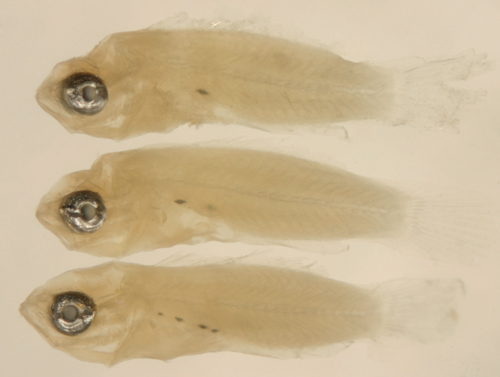 |
| Doratonotus
megalepis transitional larva |
| 6.2 mm SL |
| San Blas, Panama,
SB84-520 |
|
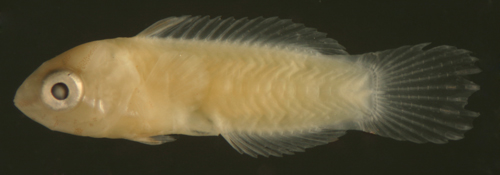 |
| |
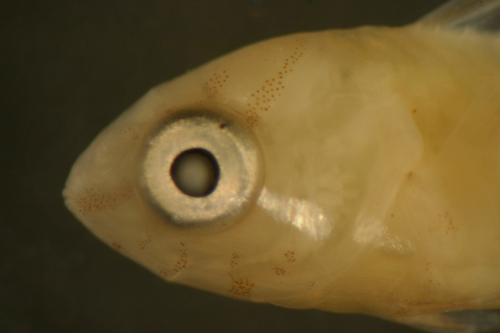 |
| |
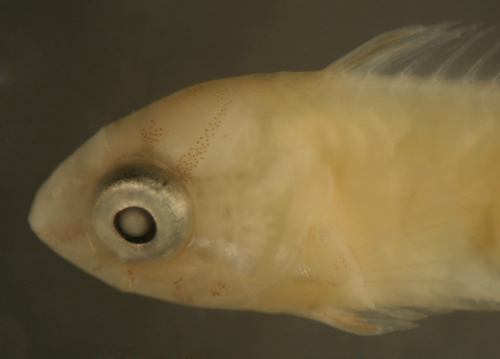 |
| Doratonotus
megalepis transitional larva |
| 6.2 mm SL |
| eye changes
with small pupil |
| San Blas, Panama,
SB86-413 |
|
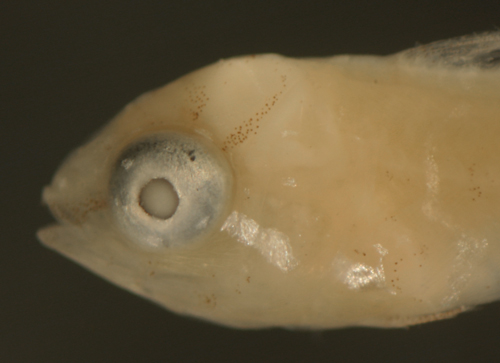 |
|
|
|
|
|
|
|
|
| Diagnosis:
The fin-ray count of D-XI,10 A-III,10 indicates
Decodon puellaris.
I have not identified larvae of D. puellaris
in my collections, but larvae corresponding
to the eastern Pacific sibling species, D.
melasma, share the fin-ray count and are
likely similar. |
|
| Analogues: |
|
| Description: |
|
|
|
|
|
|
|
|
| Diagnosis:
The fin-ray count of D-XII,10 A-III,12 and
Pect-17 indicates Clepticus
parrae. Bodianus
share the median-fin ray count, but have one
fewer pectoral-fin ray and a different body
shape. (U) |
|
| Analogues: |
|
| Description: |
|
|
| |
|
| |
|
|
|
|
|
|
|
|
| Diagnosis:
The fin-ray count of D-XII,10 A-III,12
and Pect-16 indicates Bodianus.
Clepticus
parrae shares the median-fin ray count
but has one more pectoral-fin ray and a different
body shape. The two Caribbean Bodianus
spp. share their fin-ray counts, but B.
rufus is far more common than the deep-water
species B. pulchellus
(although the latter cannot be excluded for
the pre-transitional larval stages). B.
rufus larvae develop into a bicolored
recruit with the anterior lower-half dark
blue and the rear and upper-half yellow (in
contrast to adults where it switches to the
anterior upper-half blue). Recruits of
B. pulchellus are uniformly yellow.
(U) |
|
| Analogues:
Larval Thalassoma
bifasciatum can appear similar but
have a narrower body, smaller eye, and the
dorsal-fin origin is distinctly forward on
the body. |
|
| Description:
Body relatively thin, long and wide
with a large eye and a terminal, pointed,
small mouth. Pectoral fins medium length.
Pelvic fins short. Dorsal and anal-fin bases
relatively long, caudal peduncle short and
wide. |
|
|
|
| Bodianus
rufus recruit |
| 10.1 mm SL |
| San Blas, Panama,
SB81-077 |
|
 |
| |
 |
|
|
|
|
|
|
|
|
| Diagnosis:
The fin-ray count of D-XIV,11 A-III,10 indicates
Lachnolaimus
maximus. I have not collected this
species, but Colin (1982) raised the larvae
through their larval phase. The larvae resemble
Doratonotus megalepis in basic form,
but develop surface melanophores early in
development, around the time the fin rays
are fully formed (about 5 mm SL). This feature
is particularly unusual for labrids (or other
labroids) and it is likely that this species
is the sole member of the family to have body
pigmentation (none of the Indo-Pacific labroid
larvae identified by Leis and Carson-Ewart
(2000) have this character). The adaptation
suggests that larval L. maximus are
associated with drift algae and not exposed
in the plankton. |
|
| Analogues:
In most features this larval type resembles
larval
Doratonotus megalepis, but is distinguished
by a slightly different fin-ray count and,
most conspicuously, by having extensive melanophore
patterns on the body. The arrangement of melanophores
on the head resembles that of transitional
D. megalepis and they share the markings
on the first dorsal-fin spines and pelvic
fins, but even late transitional
D. megalepis do not have the reticulated
patterns on the body. |
|
| Description:
Body relatively thin, short and wide
with a large eye and a terminal, small mouth.
Pectoral and pelvic fins short. Dorsal and
anal-fin bases relatively long, caudal peduncle
short and wide. By the time the fin-ray complement
has formed, around 5.5 mm SL, melanophores
are scattered over the body and in three discrete
patches along the anal-fin base. Subsequently,
melanophores develop in bars radiating from
the eye: forward across the jaw, a vertical
below the eye, and in bands across the top
of the head. A reticulated pattern of melanophores
then develops over the body. Since the larvae
were raised in captivity, the point of transition
cannot be determined. Series of larvae shows
the eye remains round. |
|
|
|
|
| |
 |
|
All contents © copyright
2006-2013
All rights reserved
www.coralreeffish.com
by Benjamin Victor
|
|
|
|
|
|
|
|